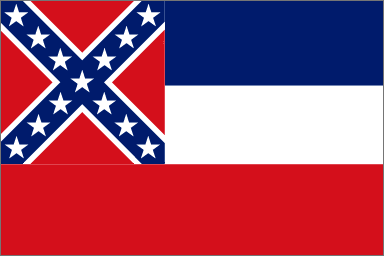Mississippi
 A state of the southeast United States. It was admitted as the 20th state in 1817. The first settlers in the region (1699) were French, and the area became part of Louisiana. It passed to the British (1763–1779) and then to the Spanish before being ceded to the United States in 1783. The Mississippi Territory, organized in 1798 and enlarged in 1804 and 1813, also included the present state of Alabama. Jackson is the capital and the largest city. It is bordered by Alabama (E), the Gulf of Mexico (S), Arkansas and Louisiana, with most of the border formed by the Mississippi R. (W), and Tennessee (N).
A state of the southeast United States. It was admitted as the 20th state in 1817. The first settlers in the region (1699) were French, and the area became part of Louisiana. It passed to the British (1763–1779) and then to the Spanish before being ceded to the United States in 1783. The Mississippi Territory, organized in 1798 and enlarged in 1804 and 1813, also included the present state of Alabama. Jackson is the capital and the largest city. It is bordered by Alabama (E), the Gulf of Mexico (S), Arkansas and Louisiana, with most of the border formed by the Mississippi R. (W), and Tennessee (N).
Where the name comes from: Possibly based on Chippewa Indian words “mici zibi,” loosely meaning “great river”. the Mississippi River, which forms most of the state’s western border.
Abbreviation: MS
Capital City: Jackson
Date of Statehood: Dec. 10, 1817
State #: 20
Population: 2,844,658
Area: 48434 sq.mi. Land 46914 sq. mi. Water 1520 sq.mi.
Agriculture: cotton, poultry, cattle, catfish, soybeans, dairy products, rice
State Bird: Mockingbird
State Flower: Magnolia
State Motto: Virtute et armis — By valor and arms
State Nickname: Magnolia State
State Song: Go Mis-sis-sip-pi
 About the Flag
About the Flag
Three broad stripes, one red, one white, one blue, make up the background of the Mississippi flag, In the upper left-hand third of the flag, is a Union Square, with a red ground upon which is a broad blue saltier bordered with white and emblazoned with thirteen stars, representing the number of the original States of the Union. Pledge to the Flag: “I salute the flag of Mississippi and the sovereign state for which it stands with pride in her history and achievements and with confidence in her future under the guidance of Almighty God
History of Mississippi
Mississippi was part of the Mississippian culture in the early part of the second millennium AD; descendant Native American tribes include the Chickasaw and Choctaw. Other tribes who inhabited the territory of Mississippi (and gave their names to local towns) include the Natchez, the Yazoo, and the Biloxi.
The first expedition into the territory that became Mississippi was that of Hernando de Soto, who passed through in 1540. However, the first settlement was that of Ocean Springs (or Old Biloxi), settled by Pierre Le Moyne d’Iberville in 1699. In 1716, Natchez was founded on the Mississippi River (as Fort Rosalie); it became the dominant town and trading post of the area. After spending some time under Spanish, British, and French nominal jurisdiction, the Mississippi area was deeded to the United States after the French and Indian War under the terms of the Treaty of Paris.
The Mississippi Territory was organized on April 7, 1798, from territory ceded by Georgia and South Carolina; it was later twice expanded to include disputed territory claimed by both the U.S. and Spain. Land was purchased (generally through unequal treaties) from Native American tribes from 1800 to about 1830.
Mississippi was the 20th state admitted to the Union, on December 10, 1817.
When cotton was king during the 1850s, Mississippi plantation owners—especially those of the Delta and Black Belt regions—became increasingly wealthy due to the high fertility of the soil and the high price of cotton on the international market. The severe wealth imbalances and the necessity of large-scale slave populations to sustain such income played a heavy role in both state politics and in the support for secession.
Mississippi was the second state to secede from the Union as one of the Confederate States of America on January 9, 1861. During the Civil War the Confederate States were defeated. Under the terms of Reconstruction, Mississippi was readmitted to the Union on February 23, 1870.
Mississippi was considered to typify the Deep South during the era of Jim Crow. A series of increasingly restrictive racial segregation laws enacted during the first part of the 20th century resulted in the emigration of almost half a million people, three-quarters of them black, in the 1940s. However, at the same time, Mississippi became a center of rich, quintessentially American music traditions: gospel music, jazz music, blues, and rock and roll all were invented, promulgated, or heavily developed by Mississippi musicians. Mississippi was also noted for its authors in the early twentieth century, especially William Faulkner and Tennessee Williams.
Mississippi was a center of the American Civil Rights Movement. While many in the state supported the effort to secure voting and other rights for African-Americans, the vocal opposition of many politicians and officials and the violent tactics of Ku Klux Klan members and sympathizers gave Mississippi a reputation as a reactionary state during the 1960s.
The state was the last to repeal prohibition and to ratify the Thirteenth Amendment, which abolished slavery, in 1966 and 1995 respectively.
On August 17, 1969, Category 5 Hurricane Camille hit the Mississippi coast killing 248 people and causing US$1.5 billion in damage (1969 dollars).
On August 29, 2005, Hurricane Katrina caused even greater destruction across the entire 90 miles of Mississippi Gulf Coast from Louisiana to Alabama.

|
|
|
